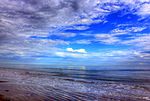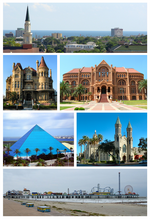Galveston Island

Galveston Island ( GAL-vis-tən) is a barrier island on the Texas Gulf Coast in the United States, about 50 miles (80.5 km) southeast of Houston. The entire island, with the exception of Jamaica Beach, is within the city limits of the City of Galveston in Galveston County. The island is about 27 miles (43.5 km) long and no more than 3 miles (4.8 km) wide at its widest point. The island is oriented generally northeast-southwest, with the Gulf of Mexico on the east and south, West Bay on the west, and Galveston Bay on the north. The island's main access point from the mainland is Interstate Highway 45 which crosses the Galveston Causeway that crosses West Bay on the northeast side of the island. The far north end of the island is separated from the Bolivar Peninsula by Galveston Harbor, the entrance to Galveston Bay and the Houston Ship Channel. Ferry service is available between Galveston Island and the Bolivar Peninsula. The southern end of the island is separated from the mainland by San Luis Pass. The San Luis Pass-Vacek Toll Bridge connects the San Luis Pass Road on Galveston Island with the Bluewater Highway that leads south into the town of Surfside Beach. The residents of the island (the nontourists) classify themselves in two ways: born on the island (BOI) and islander by choice (IBC). “BOI” is cited in print from at least 1956 and “IBC” is cited in print from 1975.
Excerpt from the Wikipedia article Galveston Island (License: CC BY-SA 3.0, Authors, Images).Galveston Island
San Luis Pass Road, Galveston
Geographical coordinates (GPS) Address Nearby Places Show on map
Geographical coordinates (GPS)
| Latitude | Longitude |
|---|---|
| N 29.222222222222 ° | E -94.908888888889 ° |
Address
San Luis Pass Road
San Luis Pass Road
77551 Galveston
Texas, United States
Open on Google Maps








